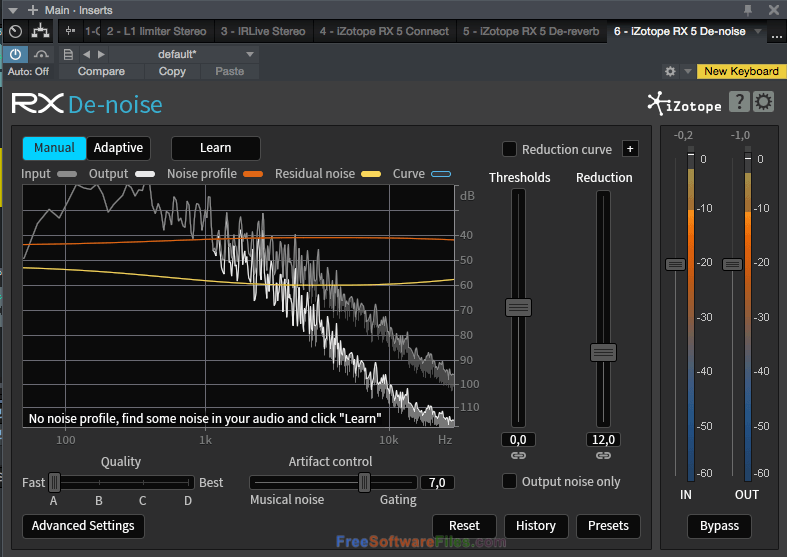Izotope Rx Dithering Gearslutz


Dither

Dither is a necessary process when converting from a higher bit resolution to a lower bit resolution.
For dithering to work, it must be the absolute last edit performed on an audio file, except for the final conversion to 16-bit depth. This means that any effect applied after dithering, even a slight gain adjustment, or a sample-rate conversion, can undermine the positive effects of your dithering. Use the links below to jump in to the RX 8 Help Documentation. Introduction RX Overview Working with Files Recording Transport Controls Spectrogram/Waveform Display Interactive Tools Undo. Are you in a hurry? Use Izotope RX and take advantage of batch processing.This is the best way to handle rendering files when you have a deadline and need to. Use the links below to jump into the RX 7 Help Documentation: Introduction RX Overview Working with Files Recording Transport Controls Spectrogram/Waveform Display Interactive Tools Undo Histor. Use the links below to jump into the RX 7 Help Documentation: Introduction RX Overview Working with Files Recording Transport Controls Spectrogram/Waveform Display Interactive Tools Undo Histor.
Dithering is used to tame the quantization distortion that happens when converting between bit depths due to requantization. Dither also preserves more of the dynamic range of a signal when converting to a lower bit depth.
The Dither module applies iZotope's MBIT+ dithering and noise shaping technology to maintain the highest audio quality possible when you are converting to 24, 20, 16, 12, or 8 bits.
MBIT+ uses psychoacoustic methods to distribute dithering noise into less audible ranges. The result is a more pleasing sound and smoother fades.
New bit depth
This sets the target resolution (bit depth) of the audio file.
Noise shaping
Chooses the aggressiveness of dither noise shaping.
It is possible to provide more effective and transparent dithering by shaping the dithered noise spectrum so less noise is in the audible range and more noise is in the inaudible range.
You can control the aggressiveness of this shaping, ranging from None (no shaping, plain dither) through Ultra (roughly 14 dB of audible noise suppression).
More noise shaping can cause slightly higher peaks in your signal, even at high bit depths.
Dither Amount
The dithering amount can be varied from None (noise shaping only) to High. In general, the Normal dither amount is a good choice.
Rx 6 Izotope
No dithering or Low dither amount can leave some non-linear quantization distortion or dither noise modulation, while higher settings completely eliminate the non-linear distortion at the expense of a slightly increased noise floor.
A dither amount setting of High with no noise shaping produces a standard TPDF dither: a common white noise generation method with a triangular distribution of amplitudes between −1 and +1 of the Least Significant Bit (LSB).
Auto-blanking
Mutes dither output (i.e. dither noise) when the input signal is completely silent (0 bits of audio).
Limit noise peaks
Dither noise is random in nature and has a very low amplitude. However, after noise shaping, especially in aggressive dithering modes like Ultra, the high-frequency dither noise is significantly amplified, and the overall dither signal can show spurious peaks up to −60 dBFS during 16-bit quantization. If such high peaks are undesirable, you can enable this option to effectively suppress the spurious peaks in the noise-shaped dither.
Suppress harmonics
If, for some reason, any dithering noise is undesirable, simple truncation remains the only choice. Truncation results in harmonic quantization distortion that adds overtones to the signal and distorts the timbre. In this case you can enable Suppress Harmonics option to slightly alter the truncation rules, moving the harmonic quantization distortion away from overtones of audible frequencies. This option doesn't create any random dithering noise floor. Instead it works more like truncation, but with better tonal quality in the resulting signal. This option is applicable only in the modes without dithering noise and without aggressive noise shaping.
RX's Resample module allows you to convert an audio file from one sample rate to another. Sample Rate Conversion (SRC) is a necessary process when converting material from one sampling rate (such as studio quality 192kHz) to another rate (such as CD quality 44.1kHz). It is common to record and edit in high sampling rates since higher rates allow higher frequencies to be represented. For example, a 192kHz audio sample can represent frequencies up to 96kHz whereas a 44.1kHz audio sample can only represent frequencies up to 22.05kHz, also known as the Nyquist frequency.
When reducing the sampling rate, or downsampling, it is crucial to remove the frequencies that cannot be represented at the lower sampling rate. Leaving frequencies above this point causes aliasing. Aliasing can be heard as the frequencies in an inaudible range are shifted into an audible range causing distortion and noise. With iZotope SRC's steep low-pass filter, users can completely avoid the common aliasing artifacts while maintaining the maximum frequency content.
Izotope Rx Resample
Read more about Resampling controls in the Reference Guide.
Dither Module
The Dither module applies iZotope's MBIT+ dithering technology to improve the quality of your audio files when you are converting to 24, 20, 16, 12, or 8 bits.
Dithering takes control of the quantization noise that happens when converting between bit depths. MBIT+ uses psychoacoustic methods to distribute dithering noise into less audible ranges. The result is a more pleasing sound and smoother fades.
Read more about Dither controls in the Reference Guide.
